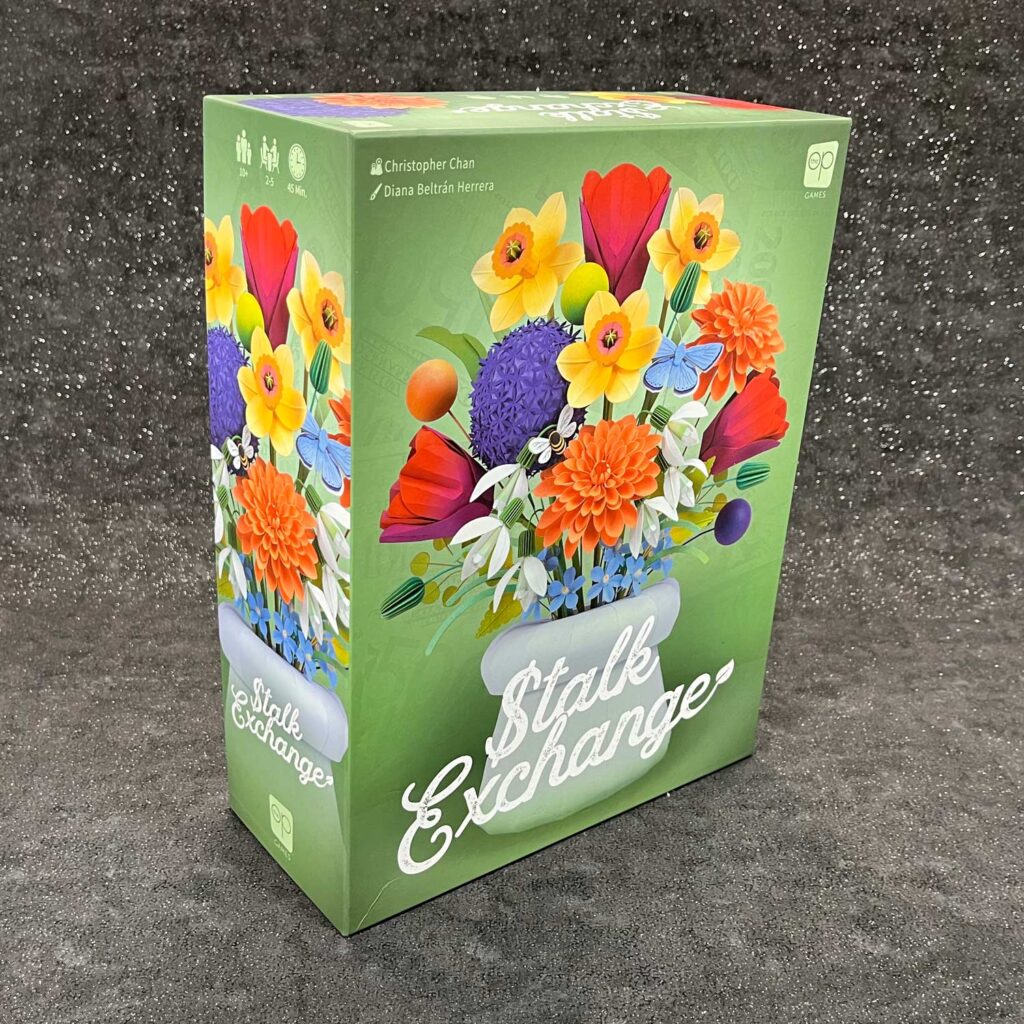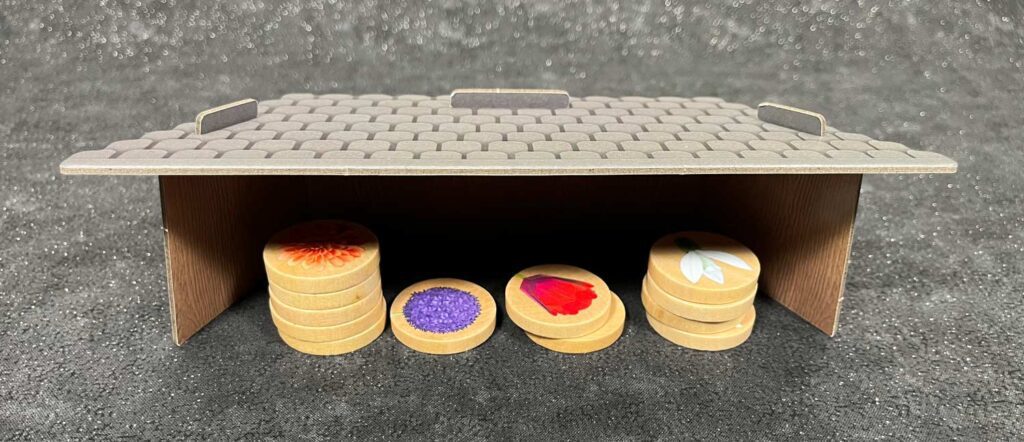Disclosure: Meeple Mountain received a free copy of this product in exchange for an honest, unbiased review. This review is not intended to be an endorsement.
At the GAMA Expo in 2024, publishers from all over the country showcased their upcoming releases. One night, in a relatively small room, I had the opportunity to look over close to 150 games from large and small publishers alike. After making a circuit of the room to see what looked interesting, the Stalk Exchange (stylized as $talk Exchange) table from The Op was the first one I came back to, and the only one in which I sat down to play an entire game. I was impressed with the artwork, the simple gameplay, and the play time—around 30 minutes or so. So when The Op offered to send a copy for review, I jumped at the chance. And everyone who’s played it so far has raved about it, some going so far as to say, “This is what a market manipulation game should look like.”
So let me share the love for Stalk Exchange.

“Flowers don’t tell, they show.” — Stephanie Skeem
In Stalk Exchange, 2-5 players compete to build the best floral portfolio, a wealth of dahlias, daffodils, globemasters, snowdrops, and tulips. You do this by planting flowers from “the exchange” into the shared garden, and by trading flowers between the exchange and your hidden portfolio. That’s it. You have two actions to choose from on your turn, and quite a bit of decision space to experiment with. So let’s expand on these two actions.
First, a quick explanation of your goals. You want to earn the most money (points) by accurately predicting the value of flowers which have already been harvested, such that you have a store of those flowers in your hidden portfolio. In short, you want to have more of the most valuable flowers than other players. The current value of each type of flower is tracked at one end of the scoreboard, while the other end is where harvested flowers are placed (more on that in a moment).

During the planting action, you select a flower, a thick wooden disc with a flower illustration on one side and a bulb on the other, from the exchange. Then you plant that flower in the garden, bulb side up.
When you select the swap action, you take a flower from your portfolio, a delightful “potting shed” in which you squirrel away your flowers, and trade it with one of the 6 flowers in the public market.

I must have flowers, always, and always.” — Claude Monet
After performing one of those actions, you work through the upkeep phase, which is where the magic happens.
First you examine the garden and harvest any flowers which are completely surrounded by the edge of the board, other flowers, or bulbs. Harvested flowers are placed one by one onto the scoring board and if any of the just placed flowers meets or passes any of the flower value markers, the end of the game is triggered. As harvested flowers are placed onto the board, not only do they speed the end of the game, but each placed flower also increases the current value of that flower type.
Second, and only after harvesting flowers, if any bulbs now have empty spaces around those, they bloom and flip over to become flowers. This enables new flowers to be harvested in the following turns.
Finally, the rightmost flower in the exchange is discarded to the compost bag, never to return. This means that you’ll always be discarding and replacing at least one flower every turn, and in some cases, several. This keeps the pace of the game moving along quite quickly.
I’ve already mentioned one way in which the game might end (the most common way), but the game might also end if the draw bag of flowers is ever empty.
“She is a little wildflower with a lot of warrior underneath”— Melody Lee
After the game ends, you score everyone’s portfolio, but not before making one crucial adjustment: the flower scoring markers furthest along the track (the most valuable), have their values cut in half, rounded up.
This means that you not only have to monitor the current value of your portfolio, but you also need to make sure the flowers you have the most of are ever so slightly less valuable than those of other players. This highlights the importance of the swap action: don’t be afraid to ditch those low-performing flowers in favor of the more valuable ones.

“Flowers are for our souls to enjoy” – Sioux proverb
I’m definitely happy to have Stalk Exchange in my collection. Because the actions are so simple, you can teach it to anyone, regardless of skill level. And players who enjoy flowers will particularly enjoy the game because the artwork is so amazing. In fact, what you might take for a drawing on the cover is actually paper artwork by artist Diana Beltrán Herrera. There’s even an entire page in the rulebook dedicated to her process—a lovely touch.
But lest you think the game is perfect, let me point out a few things to consider. There are 125 wooden discs in this game, and The Op provided two bags which are not capable of containing 125 wooden discs; at least with sufficient space to reach your hand in and shuffle them around. This is a fairly common issue with bags, and one I wish more publishers would consider. In several games, it was easier to dump them all into the box lid and pick from there, than it was to pull from the bag.
The potting sheds are cardboard, and designed to stay assembled. They’re big, about 7in wide, 4in tall, and about 5in deep. They look great, but they’re pretty big, and not terribly practical. The roof has such a low slant that they’re surprisingly hard to see under. And those of us with large hands had difficulty reaching in and rearranging our precious flowers.
These relatively minor component issues aside, Stalk Exchange is an excellent game that checks all the boxes for me. It’s very easy to teach—in every game so far I was done with teaching the game within about 5 minutes. The artwork is attractive and fits well with the theme, without getting in the way of gameplay. And the game is interesting and engaging. Because turns proceed so quickly, it’s easy to pay attention and have secret hopes that other players won’t cause your flower holdings to fluctuate too wildly.
You should still consider owning Stalk Exchange. It’s a run romp through the garden, and you won’t even get hayfever or grass stains on your pants!











